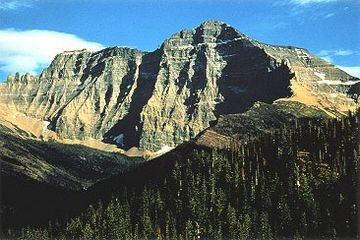Lewis Range facts for kids
Quick facts for kids Lewis Range |
|
|---|---|

Mount Cleveland is the highest peak in the Lewis Range
|
|
| Highest point | |
| Peak | Mount Cleveland |
| Elevation | 10,466 ft (3,190 m) |
| Geography | |
| Countries | United States and Canada |
| Parent range | Rocky Mountains |
| Geology | |
| Orogeny | Lewis Overthrust |
The Lewis Range is a cool group of mountains found in the Rocky Mountains. These mountains stretch across northern Montana, United States, and into southern Alberta, Canada.
This mountain range was created by something called the Lewis Overthrust. This is a special type of geologic event where older rocks ended up on top of younger rocks!
You can find parts of the Lewis Range in Waterton Lakes National Park in Canada. In the United States, it's part of Glacier National Park and the Bob Marshall Wilderness Complex. The tallest mountain here is Mount Cleveland, which stands at 10,466 ft (3,190 m).
Contents
How the Lewis Range Was Formed
The Lewis Range was shaped by a huge geological event called the Lewis Overthrust. This process started about 170 million years ago. Imagine a giant slab of very old rock, about 3 miles (4.8 km) thick.
This rock slab was also 50 miles (80 km) wide and 160 miles (260 km) long. It slowly slid over much younger rocks. This is pretty unusual in geology. Normally, older rocks are found underneath newer ones.
Exploring the Lewis Range Geography
The Lewis Range is home to some amazing natural areas. In Canada, it's part of Waterton Lakes National Park. In Montana, it includes Glacier National Park. It also covers parts of the Bob Marshall Wilderness Complex. This wilderness area is found within the Flathead and Lewis and Clark National Forests.
Major Peaks and Features
Many high peaks are part of the Lewis Range. The most famous is Mount Cleveland. It's the highest point in the range and in Glacier National Park. Other important peaks include Mount Stimson (10,142 ft/3,091 m) and Mount Jackson (10,052 ft/3,064 m).
You can also find Mount Siyeh (10,014 ft/3,052 m) and Going to the Sun Mountain (9,642 ft/2,939 m). A unique, isolated peak is Chief Mountain (9,080 ft/2,768 m).
A cool feature in the Bob Marshall Wilderness is the Chinese Wall. It's a rock formation that is 1,000 feet (304 m) high. This wall stretches for about 40 miles (64 km)!
Important Mountain Passes
Two major passes cross through the Lewis Range. Marias Pass is one of them. The other is Logan Pass. Logan Pass cuts right through Glacier National Park from east to west. These passes are important routes through the mountains.



